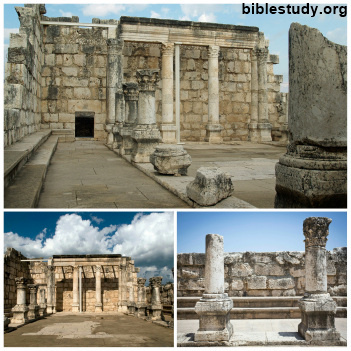Capernaum is mentioned, by name, sixteen times in the King James Bible. The gospel of John refers to it the most (John 2:12, 4:46, 6:17, 6:24 and 6:59). Its name comes from the Greek Kapernaoum (Strong's Concordance #G2584), which Thayer's Greek Definitions states means "city of comfort."
The city was located near the northwest corner of the Sea of Galilee (also known as Sea of Tiberias or Lake of Gennesaret), near the borders of Zebulun and Naphtali (the Promised Land given by God to these Israelite tribes as inheritance after Egyptian slavery). The city was on the great highway from Damascus to Acco and Tyre. Capernaum was the metropolis of Galilee and one of the most prosperous and crowded districts in all Palestine.
Capernaum itself, however, is not mentioned at all in the Old Testament and can only be found in the four gospel accounts in the New Testament. Jesus, just before his public ministry began, left his boyhood home in Nazareth and took up residence in the city. This move was a fulfillment of prophecy (see Isaiah 9:1 - 2 and Matthew 4:13 - 16).
Capernaum was the backdrop of many of Christ's mighty miracles. For example, it was in the city's Synagogue, on the Sabbath, that Jesus commanded a demon to leave the person it possessed. The miracle was so amazing that those who saw it said, "What kind of words are these? With authority and power this man gives orders to the evil spirits, and they come out!" (Luke 4:36, HBFV).

The Capernaum Sabbath on which the Luke 4 miracle took place was shortly after the day of Pentecost (Harmony of the Gospels in Modern English, page 69) and caused Christ's fame to be spread throughout the entire region.
On one occasion, word spread that Jesus was teaching in a certain Capernaum home. The building was soon packed with people. Four men carrying a paraplegic zealously wanted to have him healed but could not get to the Lord due to the crowd of people.
The four men decided to go on top of the house and dig their way through the roof. Once they had opened a sufficiently large enough hole, they slowly lowered their friend's pallet in front of where Christ was sitting. Seeing their great faith, he immediately healed their friend and said his sins were forgiven.
Some self-righteous religious leaders, who heard Jesus declare the paraplegic's sins were forgiven, thought he was blaspheming God. Christ quickly chastised the men for their evil thoughts and boldly asserted he had the authority to forgive sin (Mark 2:3 - 12, Luke 5:17 - 25).
It was also in Capernaum that, because of the great faith of a Roman Centurion, Jesus did not need to visit the man's servant who had palsy but simply commanded he be healed (Matthew 8: 5 - 13).
Other miracles which occurred in Capernaum include the healing of the nobleman's son (John 4:46 - 54), Peter's mother-in-law made well (Matthew 8:14 - 15), and the synagogue ruler's daughter brought back to life (Matthew 9:23 - 25).